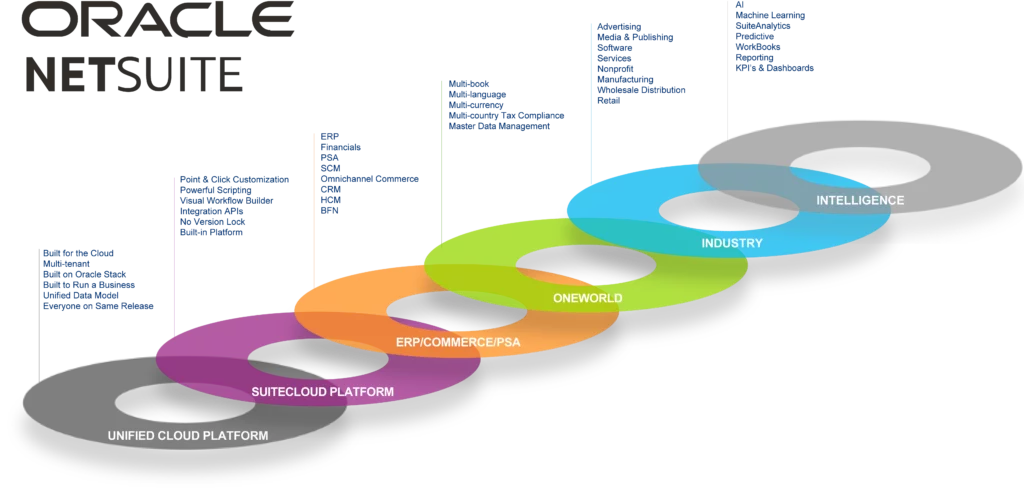In today’s fast-paced business landscape, selecting the right Enterprise Resource Planning (ERP) system is crucial for maximizing efficiency and productivity. Two popular choices in the market are NetSuite and Intacct. They both offer many features to help businesses run more smoothly.
This blog post will compare NetSuite and Intacct in various areas. These areas include customer management, project accounting, inventory management, and financial management. The post will also discuss how these two platforms meet different business needs.
Understanding NetSuite vs Intacct
NetSuite is a cloud-based ERP system owned by Oracle. It is known for its wide range of features, including financial management and CRM.
This cloud software can be used by businesses of any size, from startups to large enterprises. It is known for being scalable. NetSuite offers modules for core financials, project accounting, inventory management, and more, all seamlessly integrated into a single platform.
Intacct: On the other hand, Intacct, acquired by Sage, is another cloud-based accounting software designed primarily for financial management purposes. Intacct does not have as many accounting modules as NetSuite. However, it excels in offering advanced financial solutions tailored for complex organizational structures. It’s favored by companies seeking a comprehensive accounting software solution with advanced reporting capabilities.
Key Points of Comparison
Customer Relationship Management (CRM):
Both NetSuite and Intacct offer different CRM software features that help businesses manage customer interactions, sales pipelines, and marketing campaigns efficiently. However, NetSuite’s CRM module stands out for its robustness and seamless integration with other modules, offering a comprehensive perspective of customer data throughout the organization.
NetSuite’s CRM module provides a comprehensive solution for managing customer relationships. It helps businesses nurture leads, track interactions, and analyze sales performance accurately. Its advanced features facilitate the creation and management of customer profiles, enabling teams to gain deep insights into customer preferences, behaviors, and purchase history.
Moreover, NetSuite’s CRM seamlessly integrates with other modules within the NetSuite ecosystem, such as ERP, e-commerce, human capital management, and marketing automation, fostering a unified platform for managing all aspects of business operations. This integration ensures a smooth flow of data across departments, eliminating silos and facilitating better collaboration and decision-making.
Project Accounting:
NetSuite is a top choice for project accounting, offering a variety of features designed to streamline project management processes. Some of its standout features include project billing, tracking time and expenses, and managing resources. These all help with efficient project completion and financial monitoring.
One of NetSuite’s key strengths in project accounting lies in its robust project billing capabilities. With NetSuite, businesses can easily generate accurate invoices based on project milestones, time spent, or specific project tasks. This ensures timely billing and improved cash flow management, while also enhancing transparency and accountability throughout the billing process.
Although Intacct provides project accounting capabilities, it might not offer the same extensive range and depth found in NetSuite. NetSuite stands out as the top choice for businesses seeking a comprehensive and adaptable solution for project accounting and management. Its rich feature set and seamless integration with modules like CRM and other ERP systems make it a standout option.
Inventory Management:
NetSuite’s inventory management module provides end-to-end visibility into inventory levels, orders, and fulfillment processes. It supports multiple warehouse locations, allowing businesses to efficiently manage inventory across distributed facilities. This feature is especially useful for organizations with intricate supply chain operations or worldwide distribution networks. It allows for centralized control and coordination of inventory movements and replenishment activities.
While Intacct offers basic inventory management features, it may not match the depth and breadth of NetSuite’s offerings. NetSuite is a great choice for businesses looking to manage their inventory effectively. Its inventory management features work well with other modules like order management and financials.
Financial Management:
Both platforms offer a variety of tools to simplify financial processes and improve decision-making. These tools range from basic financial functions to advanced reporting features.
Their main services focus on key financial tasks like managing general ledger, accounts payable, and accounts receivable. Both NetSuite and Intacct provide intuitive interfaces and automated workflows to simplify these processes, ensuring accuracy and efficiency in financial transactions and record-keeping.
Customer Satisfaction:
NetSuite has high customer satisfaction rates. This is because of its wide range of features, easy-to-use interface, professional services, and top-notch customer support. Intacct also receives positive reviews for its robust financial solutions and personalized customer service.
Cost
Comparing the cost of NetSuite and Intacct involves considering various factors, including licensing fees, implementation costs, customization expenses, and ongoing maintenance fees. Both platforms have varying prices. The total cost can fluctuate depending on factors such as the organization’s size, implementation method, and specific needs. Here’s a general overview of the cost considerations for each platform:
NetSuite:
- Subscription Fees: Costs for using NetSuite are usually based on a subscription model. Users pay a regular fee depending on how many users, modules, and customization they need. Pricing tiers may vary, with options available for small businesses, mid-sized companies, and large enterprises.
- Implementation Costs: Implementation costs for NetSuite can vary depending on factors such as the complexity of the deployment, the extent of customization required, and the level of support needed from NetSuite’s implementation partners. While NetSuite offers comprehensive implementation services, additional fees may apply for specialized customization and integration work.
- Customization Expenses: NetSuite provides extensive customization options to tailor the platform to the unique needs of each business. However, customization expenses may vary depending on the complexity of the requirements and the extent of customization desired. Businesses should budget for potential customization costs during the implementation phase.
- Ongoing Maintenance Fees: NetSuite’s subscription-based pricing typically includes ongoing maintenance and support services, ensuring access to updates, patches, and technical assistance. However, businesses may incur additional fees for premium support services or specialized consulting beyond standard maintenance.
Intacct:
- Subscription Fees: Intacct charges a monthly fee based on how many people use the software and which features are needed. Pricing tiers may vary, with options available for small businesses, mid-sized companies, and enterprises.
- Implementation Costs: Implementation costs for Intacct can vary depending on factors such as the complexity of the deployment, the level of customization required, and the extent of support needed from Intacct’s implementation partners. Additional fees may apply for specialized consulting or integration work.
- Customization Expenses: Like NetSuite, Intacct offers customization options to tailor the platform to the specific needs of each business. Customization expenses may vary depending on the complexity of the requirements and the level of customization desired.
- Ongoing Maintenance Fees: Intacct’s subscription-based pricing typically includes ongoing maintenance and support services, providing access to updates, patches, and technical assistance. However, businesses may incur additional fees for premium support services or specialized consulting beyond standard maintenance.
Both NetSuite and Intacct offer subscription-based pricing models with recurring fees for licensing and maintenance. However, the total cost of ownership may differ between the two. Businesses should think about their specific needs, budget, and long-term goals when comparing NetSuite and Intacct. This will help them make a decision that fits their financial situation.
Conclusion
The choice between NetSuite and Intacct ultimately depends on the specific needs and preferences of your business. If you need a robust ERP system that goes beyond just financial management, NetSuite could be the perfect option for you. On the other hand, if your primary focus is on advanced, financial data and reporting, Intacct might better suit your requirements.
Whether you choose NetSuite or Intacct, both provide powerful solutions to streamline your business processes, improve efficiency, and foster growth. Carefully evaluate your specific business needs, taking into account factors like scalability, flexibility, and customer support. Make an informed decision that aligns with your long-term goals.
Whether you opt for the all-encompassing capabilities of NetSuite or the advanced financial solutions of Intacct, investing in the right ERP system is essential for unlocking your business’s full potential in today’s competitive landscape.
What you need, when you need it.
NetSuite is built to run a growing business. From robust financial management to integrated ERP functions including order management, inventory, CRM, e-commerce, and more—NetSuite meets the demands of today and scales with you as you succeed.

About 360 Cloud Solutions
Since 2002, 360 Cloud Solutions has helped hundreds of fast-growing companies improve their business agility by leveraging NetSuite, Adaptive Planning, and 360 Subscription Billing—along with other powerful, cloud-based tools. From licensing to implementation, services and ongoing support, we do it all.
We’ve seen, first hand, how game-changing this software can be and it is our goal to bring the benefits of the cloud to as many companies as we can.





